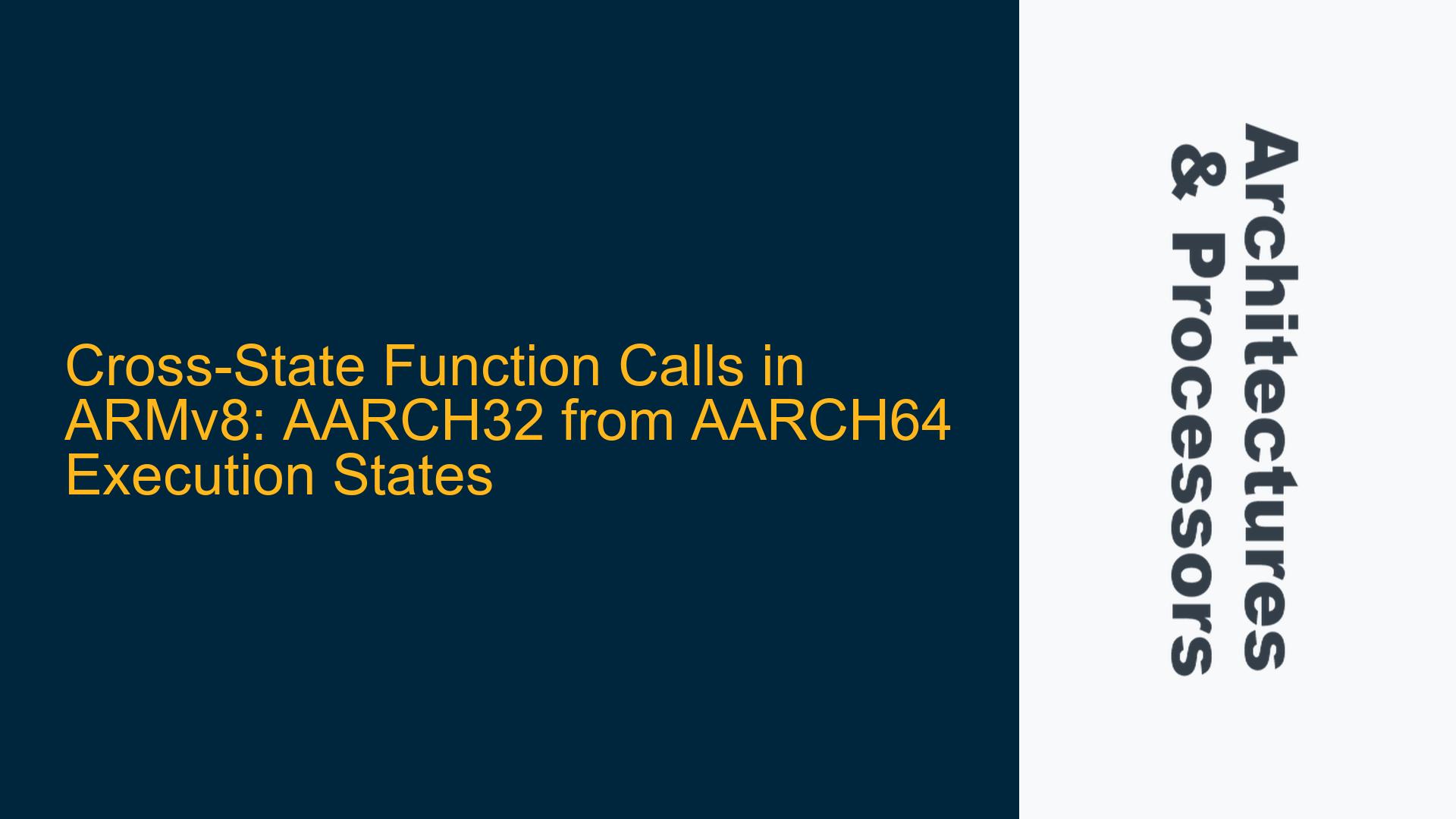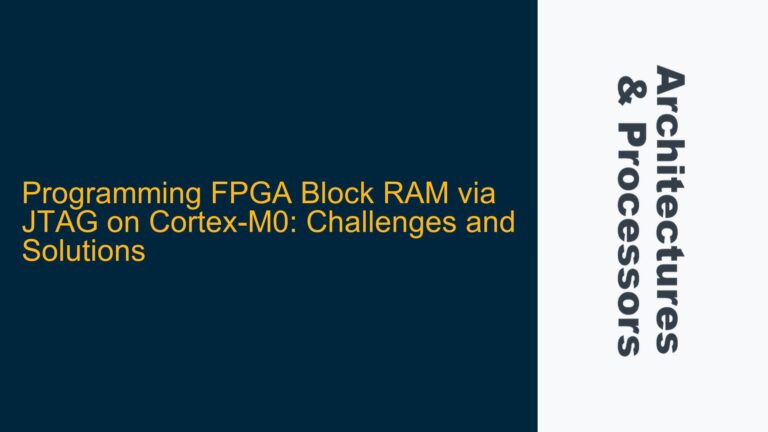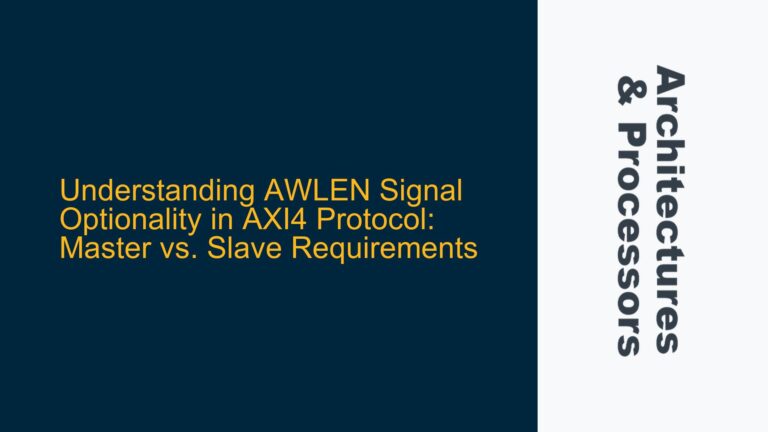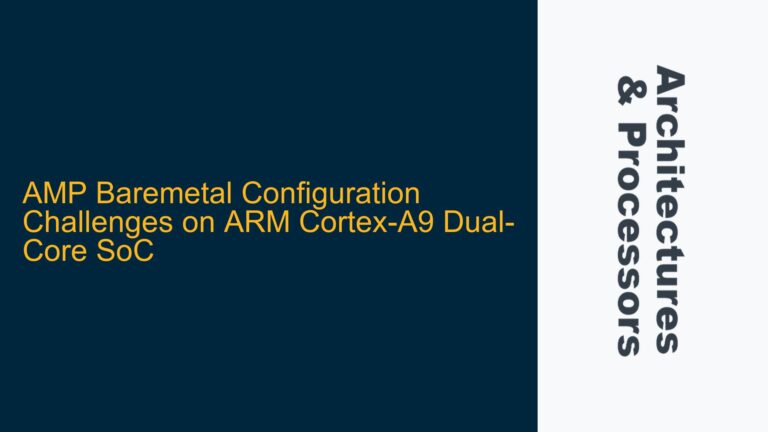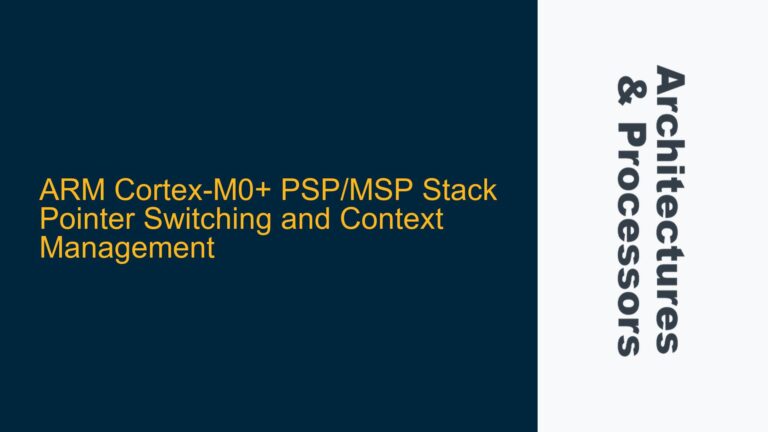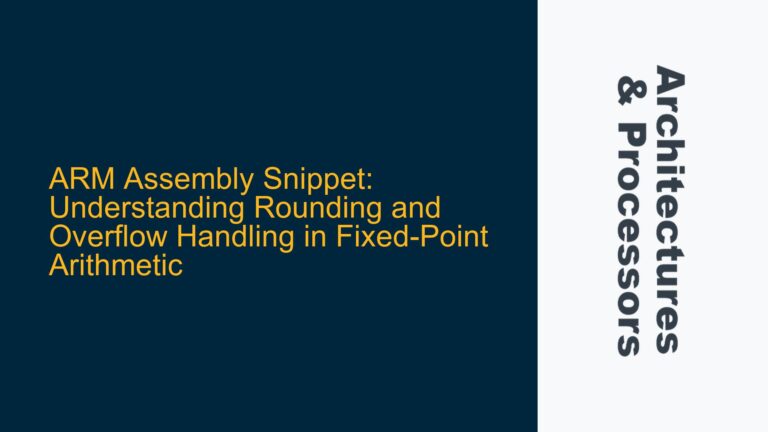ARMv8 AARCH64 to AARCH32 Function Call Challenges
The ARMv8 architecture introduces a unique challenge when attempting to call functions compiled in the AARCH32 execution state from the AARCH64 execution state. This scenario arises in systems where both 32-bit and 64-bit execution states coexist, such as in ARMv8 processors that support both AARCH32 and AARCH64 modes. The primary issue revolves around the architectural differences between these two execution states, which prevent direct function calls across state boundaries. The AARCH64 execution state operates with a 64-bit register set and a different instruction set architecture (ISA) compared to the AARCH32 state, which uses a 32-bit register set and a compatible ISA with ARMv7. This discrepancy necessitates a mechanism to transition between the two states seamlessly, ensuring that function calls can be executed without causing undefined behavior or system crashes.
The problem is further complicated by the privilege levels (EL0 to EL3) in ARMv8. Each privilege level has its own execution state, and transitioning between these levels often requires careful handling of the processor state, including the stack, registers, and exception handling mechanisms. For instance, a function call from AARCH64 EL1 to AARCH32 EL0 cannot be performed directly due to the architectural differences and the need to maintain system integrity. This situation is common in mixed-mode applications, where legacy 32-bit code needs to interact with modern 64-bit code, such as in embedded systems with real-time operating systems (RTOS) or hypervisors.
The core challenge lies in the fact that the ARMv8 architecture does not provide a direct mechanism for cross-state function calls. Instead, the transition must be managed through exceptions, which involve saving the current state, switching to the target execution state, executing the function, and then restoring the original state. This process is not only complex but also introduces potential performance bottlenecks and points of failure if not implemented correctly. Understanding the intricacies of this transition is crucial for developers working on ARMv8 systems that require interoperability between AARCH32 and AARCH64 code.
Exception Handling and State Transition Mechanisms
The primary cause of the inability to directly call AARCH32 functions from AARCH64 execution states is the architectural separation between the two states. ARMv8 processors are designed to operate in either AARCH32 or AARCH64 mode, but not both simultaneously. This separation is enforced at the hardware level, meaning that the processor must explicitly switch between states to execute code compiled for the other state. This switch is typically accomplished through exception handling, where the processor transitions from one execution state to another by raising an exception, executing the target code, and then returning from the exception.
One of the key challenges in this process is the management of the processor state during the transition. When an exception is raised, the processor must save the current state, including the program counter (PC), stack pointer (SP), and general-purpose registers, to ensure that it can resume execution correctly after the exception is handled. In the context of cross-state function calls, this involves saving the AARCH64 state, switching to AARCH32 mode, executing the function, and then restoring the AARCH64 state. This process requires careful coordination to ensure that the state is preserved accurately and that no data is lost or corrupted during the transition.
Another critical aspect is the handling of the exception return address. In ARMv8, exceptions are handled by the exception vector table, which contains pointers to the exception handlers for each exception level. When an exception is raised, the processor jumps to the appropriate handler in the vector table, which then performs the necessary state transition. For cross-state function calls, the exception handler must be configured to switch to the target execution state and execute the function. After the function completes, the handler must return to the original execution state and resume execution from the point where the exception was raised. This requires precise management of the exception return address and the processor state to ensure that the transition is seamless and that the system remains stable.
The use of exceptions for cross-state function calls also introduces potential performance overhead. Exceptions are relatively expensive in terms of processing time, as they involve saving and restoring the processor state, updating the exception return address, and potentially flushing caches or pipelines. In systems where cross-state function calls are frequent, this overhead can become significant and may impact the overall performance of the application. Therefore, it is essential to optimize the exception handling mechanism to minimize the performance impact while ensuring that the state transition is handled correctly.
Implementing Cross-State Function Calls with Exception Handling
To implement cross-state function calls between AARCH64 and AARCH32 execution states, developers must carefully design the exception handling mechanism to ensure a seamless transition. The first step is to configure the exception vector table to handle the specific exception that will be used for the state transition. This involves setting up the exception handler to save the current state, switch to the target execution state, execute the function, and then restore the original state. The exception handler must be written in assembly language to ensure precise control over the processor state and to avoid any potential issues with compiler-generated code.
The next step is to save the current state before raising the exception. This includes saving the program counter (PC), stack pointer (SP), and general-purpose registers to a secure location, such as a dedicated memory area or a stack frame. The saved state must be preserved accurately to ensure that the processor can resume execution correctly after the exception is handled. Once the state is saved, the exception can be raised, and the processor will jump to the exception handler.
In the exception handler, the processor must switch to the target execution state. This involves setting the appropriate bits in the processor’s control registers to switch from AARCH64 to AARCH32 mode. Once the switch is complete, the handler can execute the target function. After the function completes, the handler must restore the original state by switching back to AARCH64 mode and restoring the saved state. This includes restoring the program counter, stack pointer, and general-purpose registers to their original values.
To ensure that the transition is seamless, developers must also manage the exception return address correctly. The exception return address must be set to the point where the exception was raised, so that the processor can resume execution from the correct location. This requires careful management of the exception return address in the exception handler, as well as ensuring that the saved state is restored accurately.
In addition to the technical implementation, developers must also consider the performance implications of using exceptions for cross-state function calls. To minimize the performance overhead, developers should optimize the exception handling mechanism by reducing the number of state saves and restores, using efficient memory access patterns, and avoiding unnecessary cache flushes or pipeline stalls. Additionally, developers should consider using hardware features, such as the ARMv8-A architecture’s support for nested virtualization, to further optimize the state transition process.
By carefully designing and implementing the exception handling mechanism, developers can achieve seamless cross-state function calls between AARCH64 and AARCH32 execution states in ARMv8 processors. This approach ensures that the system remains stable and that the performance impact is minimized, enabling developers to leverage the full capabilities of the ARMv8 architecture in mixed-mode applications.
Optimizing Cross-State Function Calls for Performance and Reliability
Optimizing cross-state function calls between AARCH64 and AARCH32 execution states requires a deep understanding of the ARMv8 architecture and the specific requirements of the application. One of the key considerations is the management of the processor state during the transition. To minimize the performance overhead, developers should aim to reduce the number of state saves and restores by optimizing the exception handling mechanism. This can be achieved by using efficient memory access patterns, such as storing the saved state in a contiguous memory block, and by avoiding unnecessary cache flushes or pipeline stalls.
Another important consideration is the use of hardware features to optimize the state transition process. ARMv8-A processors provide several features that can be leveraged to improve the performance and reliability of cross-state function calls. For example, the architecture’s support for nested virtualization allows developers to create virtual machines that can run in different execution states, enabling more efficient state transitions. Additionally, the use of hardware-assisted virtualization can reduce the overhead of exception handling by offloading some of the state management tasks to the hardware.
Developers should also consider the impact of cross-state function calls on the overall system performance. In systems where cross-state function calls are frequent, the performance overhead of exception handling can become significant. To mitigate this, developers should carefully analyze the performance characteristics of the application and identify any bottlenecks that may be caused by the state transition process. This may involve profiling the application to identify the most frequently called functions and optimizing the exception handling mechanism for these functions.
In addition to performance optimization, developers must also ensure that the cross-state function calls are reliable and do not introduce any potential points of failure. This requires thorough testing of the exception handling mechanism to ensure that the state is preserved accurately and that the system remains stable during the transition. Developers should also consider the impact of interrupts and other asynchronous events on the state transition process, as these events can potentially disrupt the state management and cause the system to crash.
By carefully optimizing the exception handling mechanism and leveraging the hardware features of the ARMv8 architecture, developers can achieve high-performance and reliable cross-state function calls between AARCH64 and AARCH32 execution states. This approach enables developers to create mixed-mode applications that leverage the full capabilities of the ARMv8 architecture, while minimizing the performance impact and ensuring system stability.
Conclusion
Cross-state function calls between AARCH64 and AARCH32 execution states in ARMv8 processors present a unique challenge that requires careful design and implementation. The architectural differences between the two execution states prevent direct function calls, necessitating the use of exception handling to manage the state transition. By understanding the intricacies of the ARMv8 architecture and optimizing the exception handling mechanism, developers can achieve seamless cross-state function calls that are both performant and reliable. This approach enables the development of mixed-mode applications that leverage the full capabilities of the ARMv8 architecture, while ensuring system stability and minimizing performance overhead.
